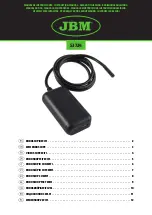
Page
11
ML434_ES | v11
Expo Technologies UK
T: +44 (0) 20 8398 8011
Expo Technologies US
T: +1 (440) 247 5314
Expo Technologies China
T: +86 532 8906 9858
Oil Class 2
In each cubic metre of compressed air, not more than 0.1mg of oil is allowed. This is a total level for liquid oil,
oil aerosol and oil vapour.
When an inert gas is being used to supply the purge system, risk of asphyxiation exists. Refer to Application
Suitability section.
Before connection of the air supply to the purge system, the supply pipe work should be flushed through with
instrument quality air to remove any debris that may remain in the pipes. This must be carried out for at least
10 seconds for every meter of supply pipe.
Unless a supply shut-off valve has been fitted to the MiniPurge
®
system, an external shut-off valve with the
same, or larger, thread size as the Control Unit inlet fitting should be fitted by the installer to prevent any
restriction of purge flow.
The purge air from the MiniPurge
®
Control Unit should be piped within the pressurized enclosure to ensure
purging of potential dead air spots.
The purge system is fitted with an internal regulator factory set to 3 bar feeding the logic.
Pipe Work
If the MiniPurge
®
is not connected directly to the pressurized enclosure, pipe work and fittings used to connect
the Control Unit to the pressurized enclosure should be either metallic or appropriate to the environment into
which the system is installed. No valve may be fitted in any signal pipe connecting the Control Unit to the
pressurized enclosure. This pipe work must be fitted in accordance with local codes of practice where relevant.
Multiple Enclosures
This system is suitable for the purge and pressurization of the primary pressurized enclosure and its
associated terminal boxes.
Provision and Installation of Alarm Devices
When the pressure inside the pressurized enclosure is above the minimum, the Minimum Pressure Sensor re-
turns a positive (
pressurized
) signal causing the alarm indicator on the control unit to change from
red
to
green
.
When the pressure falls below the minimum permissible the positive (
pressurized
) signal is removed. This ab-
sence of signal indicates a
low pressure alarm
condition and causes the alarm indicator on the control unit
to go from
green
to
red
.
There are volt free (dry) contacts available within the terminal box for remote usage.
The user must make use of this alarm facility in accordance with the local code of practice for Action on Pres-
sure or Flow Failure. Most codes include the following recommendations:
•
Zone 1 Installations:
Alarm and Automatic Trip of Power.
•
Zone 2 Installations:
Alarm Only on pressure or flow failure with power being removed manually.
Power Supplies and their Isolation
All power entering the pressurized enclosure should have a means of isolation. This requirement also applies
to any external power sources that are connected to the equipment such as volt-free (dry) contacts within the
pressurized enclosure. This is commonly achieved using the Power Interlock Switch.














































